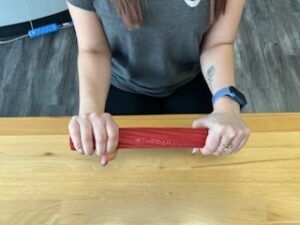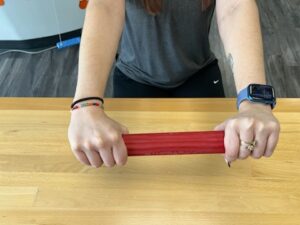 Lateral Epicondylitis Conservative Management
Lateral Epicondylitis Conservative Management
WHAT IS LATERAL EPICONDYLITIS?
Lateral epicondylitis is a repetitive stress condition in which the extensor wad, most commonly the extensor carpi radialis brevis (ECRB), has increased friction and swelling decreasing glide, general mobility and function of the extensor wrist. Typically, tenderness to palpation is found at the lateral, or outside, portion of the elbow. This will limit function, motion, and strength of the wrist and elbow. The repetitive stress on the lateral epicondyle causes friction and eventually micro-tears to the outside of the elbow which cause an increase in pain. This condition is also often called “tennis elbow” due to the typical stress placed on the elbow during a tennis swing while making contact with the tennis ball. The most common risk factors are repetitive palm down (pronation) with wrist backward (extension) motions, repetitive gripping with palm down, and has some link to age or metabolic conditions.
CAN HAND THERAPY REALLY HELP?
Occupational therapy, and more specifically hand therapy, is one of the best treatments for this condition. Therapy is extremely useful with multiple types of treatment including stretching, mobilizing the radial head to reduce friction, massage techniques, and exercise techniques that load and increase blood flow to the area. Conservative treatment with eccentric loading and exercises have been found in research to be incredibly helpful with the treatment of this condition. In addition to general treatment strategies, learning strategies of how to modify activities, work stations, and how to position to arm can be extremely helpful at managing the condition and warding off future re-occurrences. See below for a few eccentric loading exercises with a flex bar. If you would like to learn more about options for exercise, please click below to schedule an appointment with one of our qualified therapists.

Begin with the elbow flexed and the forearms pronated

Next move the wrist into extension while the elbow is flexed at 90 degrees and patient holding the flex bar in pronation

The next exercise starts with the elbows extended and the forearms pronated

Then have the patient extend the wrist while in the position of the elbow extended and the forearms pronated
CAN’T I JUST USE THE COUNTER-FORCE BRACE/ARM STRAP?
NO! The strap can certainly assist with this condition, but it is not an answer for long term help. Most of the time, it is found that people wear these straps: 1. too frequent, 2. at the wrong times, or 3. in a position where more pain is caused due to compression of the radial nerve at the radial tunnel. These straps have specific positioning to wear them correctly and need to be weaned quickly to be efficient. If someone is only managing this condition with use of the strap or counter-force brace, there is a higher likelihood of re-occurrence as well as a longer time the condition will affect the patient. It is strongly recommended that you receive some therapy or at least have an assessment to ensure you are donning and doffing this brace appropriately.
Do you believe you have this condition, have some general elbow pain, or have someone you know that may benefit from an expert therapist assisting with this condition? Click HERE for information and schedule an appointment!
 To read more about Brittany Moya MS, OTR/L, CHT,
To read more about Brittany Moya MS, OTR/L, CHT,
please click HERE for bio link.

